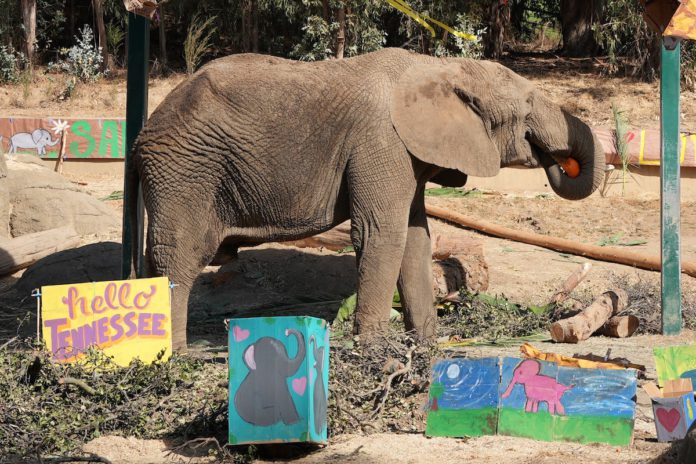Osh (male), Oakland Zoo’s last African elephant, has settled in his new home at The Elephant Sanctuary in Tennessee (The Sanctuary), an accredited Association of Zoos and Aquariums (AZA) facility. Accompanying him on his almost 46-hour-long road trip to Tennessee were his Oakland Zoo Animal Care Team members and a Zoo Veterinarian. The Zoo announced Osh’s departure in July and the decision to relocate to The Sanctuary, a decision made from commitment to caring for animal wellbeing and providing a home that meets companionship needs.
Moving an elephant is challenging, Osh’s Animal Care Team worked with him several times a week through voluntary training to help him get used to his custom air-conditioned trailer, which was built to accommodate his 15,000 lb. weight and 11’2″ height. Osh’s keepers described him as highly adaptable, calm, and resilient. The Zoo’s Veterinary Hospital staff conducted foot and tusk radiographs, blood tests, and physical and visual exams. When loaded onto his trailer last Wednesday morning, he was prepared and healthy.
The journey to Tennessee was smooth, and Osh remained calm throughout. The team, consisting of two of Osh’s Oakland Zoo animal care keepers and an Oakland Zoo veterinarian, stopped every three hours to check on Osh and feed him. He ate celery, beet pulp, and many watermelons during his drive. The team could also monitor him closely with cameras in his trailer. After his long drive, he felt tired but was eager to explore his new home in Tennessee. He joyfully began clearing trees, eating, and roaming his new habitat.
“After caring for Osh for almost twenty years, I’ve had the privilege of seeing him grow and build a bond. After only a few days at The Sanctuary, he continues to be a rambunctious and resilient being, joyfully exploring his new habitat. My heart is so full seeing Osh at his new forever home,” says Gina Kinzley, Zoological Manager at Oakland Zoo.
Two new 3,000-square-foot bull barns have been added at The Elephant Sanctuary for Osh and his new companion, Artie, a 41-year-old male African elephant. Osh has begun interacting with Artie through fence lines.
The dedicated care team at The Sanctuary visited Osh in August of this year to get to know him better. They also discussed and received a comprehensive background on Osh’s medical history from the Oakland Zoo’s Veterinary Hospital staff.
The Sanctuary staff have helped Osh settle into his new home and provided comprehensive support during his transition. Once he is fully settled, they will consistently update the public on his progress through social media. His community can continue to follow his journey online through The Sanctuary’s Elecams.
The elephants at Oakland Zoo, including Osh, have been beloved icons in the community for many years, serving as animal ambassadors for their counterparts in the wild.
“It is undeniable that Osh and the other African elephants who have lived at the Zoo have made a deep impact in Oakland. They have left a mark on our staff and zoo community, who love them. We know this is the right decision for Osh, and we are celebrating his future, his ability to be with other elephants, and the next chapter of his life,” says Nik Dehejia, CEO of Oakland Zoo
To honor the special relationship between the elephants and the community, the Zoo has been showcasing guest elephant memories online and hosting events to see Osh before he left, including a Farewell Party held last week.
The Zoo has maintained an elephant program for 75 years, which has evolved into the innovative and industry-leading program it is today. In 1991, Oakland Zoo was the first institution to broadly adopt the “protected contact” methodology with our male and female elephants. This methodology places barriers between zookeepers and elephants and incorporates cooperation through rewards rather than discipline. The standard at the time was to share space with elephants and use a tool called the bullhook to control and punish elephants.
Through community donations, the Zoo raised $500K to fund Osh’s move and to fulfill its elephant conservation and welfare commitment for the year With Osh’s move, the Zoo will be without elephants for the first time in 75 years. This provides the opportunity for the Zoo to reimagine the future of the elephant habitat. As the Zoo continues to assess its Long-Range Plan, more updates on the future of the elephant habitat will be available in 2025.




